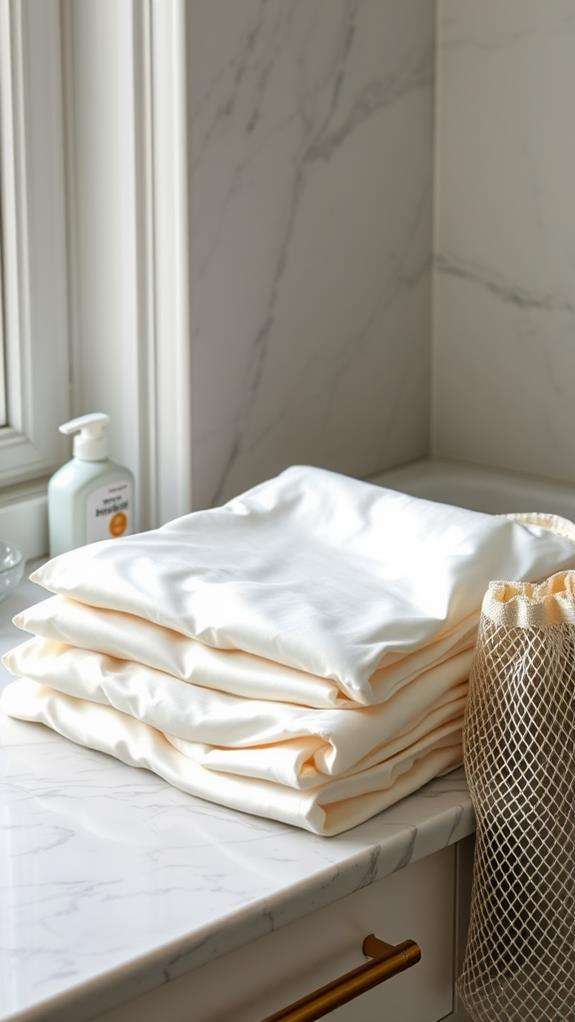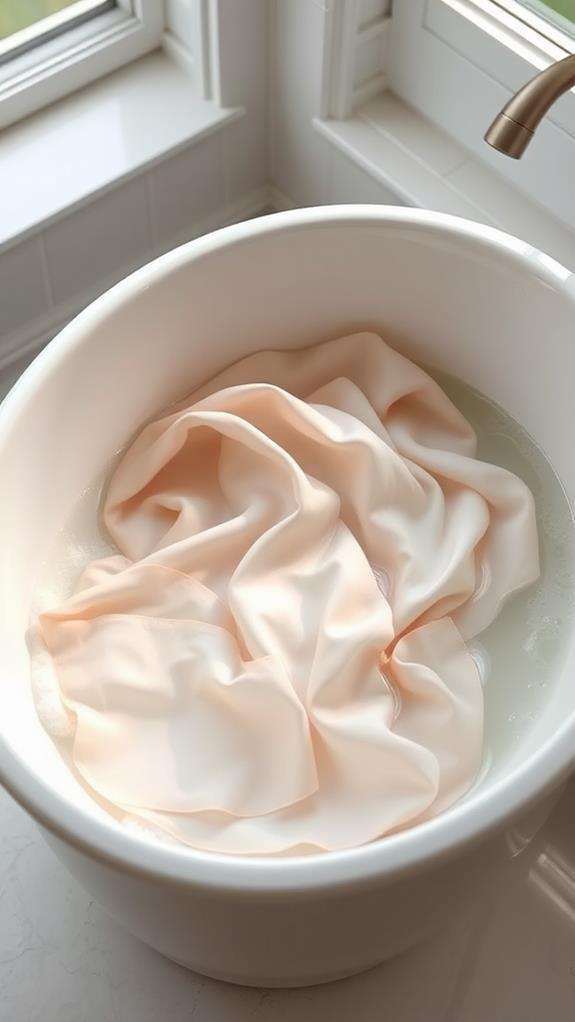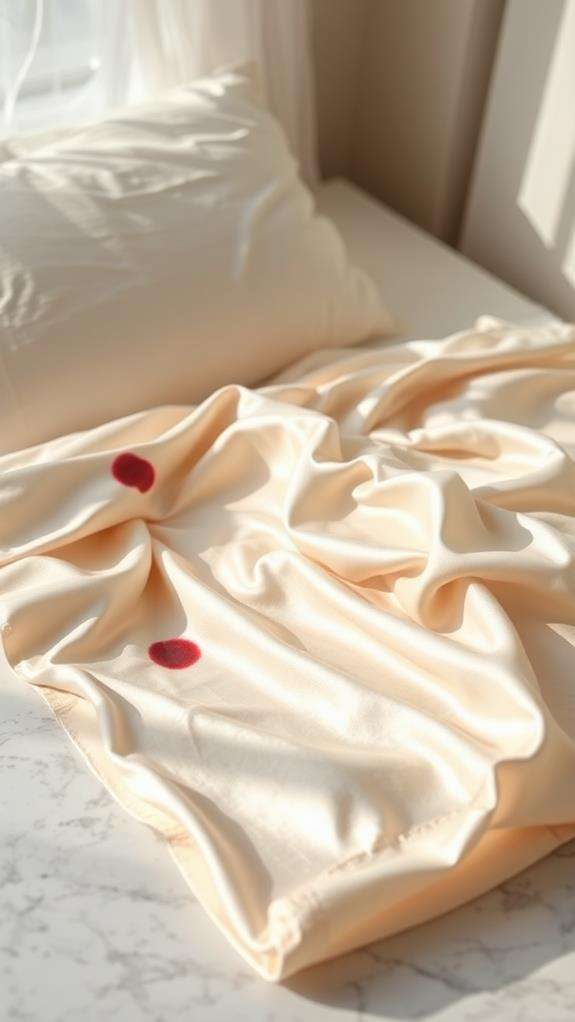How to Wash Silk Sheets
To wash silk sheets properly, you'll need to handle them with extra care using specific techniques. Start by turning the sheets inside out and placing them in a mesh laundry bag. Whether machine washing or hand washing, always use cold water (below 80°F) and a pH-neutral detergent specifically made for silk. For machine washing, select the delicate cycle; for hand washing, gently agitate the sheets for 5-10 minutes. Never wring the fabric; instead, blot excess water with white towels and air dry flat away from direct sunlight. While these basic steps will protect your sheets, proper stain removal and storage techniques can markedly extend their lifespan.
This post may contain affiliate links. If you make a purchase through these links, I may earn a commission at no additional cost to you. Additionally, portions of this post may be generated using artificial intelligence (AI) technology. While we strive for accuracy, please be aware that AI-generated content may not always be perfect and should be fact-checked when necessary.
The Spatula Scoops
- Use cold water (below 80°F) and a gentle, pH-neutral detergent specifically formulated for silk fabrics.
- Turn sheets inside out and place them in a fine mesh laundry bag before washing.
- Select the delicate or gentle cycle if machine washing, or hand wash by gently agitating for 5-10 minutes.
- Air dry silk sheets flat in a shaded area, avoiding direct sunlight and never use hot dryer settings.
- Wash silk sheets separately from other fabrics to prevent damage and minimize friction during washing.
Essential Tools and Materials

Before washing your silk sheets, gathering the right supplies guarantees a safe and effective cleaning process. You'll need to start with a specialized, pH-neutral detergent that's specifically formulated for natural fibers, as regular detergents can be too harsh and damage your delicate silk sheets.
Protect your investment by acquiring fine mesh laundry bags, which serve as essential barriers against snags and tears during machine washing. If you prefer to hand wash, you'll want to have a clean utility sink or a spacious bucket ready for the task. The gentle handling of silk requires proper tools for moisture management, so stock up on white, lint-free towels for the blotting method, which safely removes excess water without stretching or wringing the fabric.
For the drying process, you'll need to set up a dedicated drying area away from direct sunlight. A sturdy clothesline or drying rack in a shaded, well-ventilated space works perfectly. Remember to position your drying setup before you begin washing, as wet silk requires immediate attention to prevent water spots and unwanted creasing.
Preparing Silk Sheets for Washing

Setting up your silk sheets properly before washing can make all the difference in maintaining their luxurious quality. Before you begin, read the care label carefully, as it contains crucial information specific to your sheets' fabric composition and recommended washing methods.
Start by turning your silk sheets inside out to protect the fabric's exterior surface and preserve its natural sheen. You'll want to place them in fine mesh laundry bags, which act as a protective barrier against snags and tears during washing. To avoid damage, make certain you're washing silk sheets separately from other fabrics – even delicate ones – as silk requires special handling.
Select a silk-specific detergent with a neutral pH before you begin. Regular detergents can be too harsh and may compromise the fabric's integrity. When preparing your washing machine, set it to the delicate cycle and adjust the water temperature to cool (below 80°F). If you're hand washing, which is often the gentler option, prepare a basin with cool water and your gentle detergent. Remember to dissolve the detergent completely before adding your sheets to guarantee even cleaning.
Choosing the Right Detergent

For silk sheets, selecting the right detergent is essential to preserving their luxurious quality. You'll want to focus on finding a gentle detergent that's specifically formulated for silk and other delicate fabrics. The key is choosing a pH neutral product that won't compromise your sheets' integrity while effectively cleaning them.
When shopping for silk detergent, you'll need to check the label carefully and avoid products containing enzymes, which can break down silk fibers over time. Harsh chemicals and brighteners are also off-limits, as they can cause unwanted discoloration and damage to your silk sheets. Instead, look for specialized cleaners like Heritage Park Luxury Silk and Wool Detergent, which is designed to maintain silk's natural sheen and softness.
You'll find that the best detergents for silk are those explicitly labeled for delicate fabrics. These formulations strike the perfect balance between effective cleaning and gentle care. Remember that using the wrong detergent can lead to permanent damage, so it's worth investing in a proper silk-specific product that will help maintain your sheets' quality for years to come.
Machine Washing Instructions

Before tossing your silk sheets into the washing machine, you'll need to turn them inside out and place them in a fine mesh laundry bag to prevent snags and tears. For ideal machine settings, set your washer to a cold water temperature below 80°F and select the delicate or gentle cycle option, which helps protect the silk's delicate fibers during washing. Make sure you're washing your silk sheets separately from other fabrics to prevent friction damage, and check that your chosen detergent is specifically formulated for silk fabrics before starting the cycle.
Pre-Wash Preparation Steps
Proper preparation is essential when machine washing your delicate silk sheets. Before you start, carefully inspect your care label for any specific instructions that might differ from standard silk care guidelines. You'll want to turn your sheets inside out to minimize friction during the washing process, which helps preserve the fabric's exterior surface.
| Preparation Step | Purpose |
|---|---|
| Check care label | Guarantee proper handling |
| Turn inside out | Protect exterior fabric |
| Use mesh bags | Prevent tears and snags |
Place your silk sheets in fine mesh laundry bags, which act as protective barriers during the wash cycle. You'll need to set your washing machine to the delicate or silk cycle and verify that the water temperature is cool, staying below 80°F to protect the delicate fibers. Don't mix your silk sheets with other fabrics – always opt for a silk-only load to prevent potential damage from zippers, hooks, or other harsh materials. This separation also eliminates the risk of color bleeding, which can permanently stain your luxury bedding. By following these preparation steps carefully, you'll greatly reduce the chance of damaging your silk sheets during the washing process.
Gentle Cycle Settings Guide
When washing silk sheets in your machine, selecting the right cycle settings plays an essential role in preserving their luxurious quality. You'll want to set your machine to the gentle cycle or delicate fabric setting to minimize agitation that could damage your sheets. If your machine doesn't have these options, consider using the hand wash setting instead.
Always use cool water, keeping the temperature below 80°F to protect silk fibers and maintain their integrity. Before starting the cycle, place your sheets in a mesh laundry bag to prevent snags and tears during washing. You'll need to wash silk sheets separately from other items, as mixing fabrics can lead to damage from friction and tangling.
Choose a detergent for sensitive skin that's specifically formulated for delicate fabrics, and avoid bleach or fabric softeners at all costs. These harsh chemicals can break down silk fibers and reduce your sheets' lifespan. Once the cycle is complete, don't put your sheets in the dryer – instead, hang dry them away from direct sunlight to preserve their quality and prevent damage to the delicate fabric.
Hand Washing Steps

Gentle hands are vital for washing your delicate silk sheets. When you're ready to hand wash your precious bedding, start by filling your utility sink or bathtub with cold water and adding a gentle detergent specifically formulated for silk fabrics. You'll want to make sure the water completely covers your sheets when you submerge them.
Once your sheets are in the water, gently agitate them for 5-10 minutes, but don't scrub or rub the fabric, as this can damage the delicate silk fibers. After washing, it's essential to rinse your sheets thoroughly in cold water, making sure you've removed all soap residue. Instead of wringing out the excess water, which can harm the fabric, gently blot your sheets between clean white towels to preserve their quality.
The final step is vital for maintaining your silk sheets' integrity: lay them flat to air dry in a shaded area. You'll want to avoid direct sunlight at all costs, as it can cause fading and weaken the silk fibers. Following these careful steps will help guarantee your silk sheets maintain their luxurious feel and appearance for years to come.
Proper Drying Techniques

Drying silk sheets correctly is just as essential as washing them properly. After you wash silk sheets, your first step should be using the blotting method with clean white towels to remove excess water, rather than wringing out the fabric which can damage the delicate silk fibers.
When it comes to drying your silk sheets, you'll want to hang them in a shaded area to protect their quality. Never expose silk to direct sunlight, as this can cause unwanted fading and deterioration of the material. Line drying is your best option, as it provides excellent air circulation that helps maintain softness and the signature silk sheen. If you must use a dryer, only select the no-heat or air-only setting to protect the delicate silk from heat damage.
Before storing your sheets, verify they're completely dry to prevent mildew growth. Once they're thoroughly dried, place them in a cool, dark place for storage. You'll know your sheets are ready for storage when they feel perfectly dry to the touch and maintain their natural smoothness. This careful approach to drying will help preserve your silk sheets' quality for years to come.
Stain Removal Methods

Since accidents happen even with the most careful handling, knowing how to remove stains from silk sheets is essential for maintaining their beauty. You'll want to act quickly but carefully, using appropriate techniques that won't damage your delicate silk fibers.
When dealing with stains on silk sheets, follow these proven steps for the best results:
- Immediately blot the stained area with a clean white cloth, absorbing excess liquid without rubbing or pressing too hard
- Mix a gentle pH-neutral detergent specifically made for silk with cold water, then carefully dabble on the stain using light, gentle motions
- For natural stain removal, create a solution of equal parts water and white vinegar as an alternative to harsh chemicals
- Always test your chosen solution on an inconspicuous area first before treating the visible stain
After applying your chosen treatment, you'll need to thoroughly rinse with cool water to remove soap residue. Don't wring or twist the fabric while rinsing. Instead, press gently to remove excess water, then allow your silk sheets to air dry away from direct sunlight to prevent fabric damage or discoloration.
Storage and Maintenance Tips

Proper storage habits play an essential role in extending the life of your silk sheets. To prevent fading and fiber deterioration, you'll want to store silk sheets in a cool, dry environment away from direct sunlight. It's vital to choose the right storage solution that promotes air circulation while protecting your luxurious bedding from dust and debris.
You'll find that breathable storage bags or cotton pillowcases make excellent containers for your silk sheets, as they allow proper ventilation while keeping dirt at bay. Before using sheets that have been stored for a while, take time to air them out thoroughly to maintain freshness and avoid mustiness. If you're storing your silk sheets in a closet or drawer, verify the space isn't humid, as moisture damage can lead to mold growth that ruins the fabric. Instead of traditional folding, which can create permanent creases, try storing your sheets either flat or gently rolled. This technique helps prevent creasing and maintains their luxurious appearance. When you do need to fold them, use tissue paper at the fold points to minimize sharp creases that could damage the fibers.
Silk Sheet Longevity Guide

To maximize your silk sheets' lifespan, you'll need to protect the delicate fibers from common damage sources like rough surfaces, excessive heat, and harsh chemicals. Your silk sheets will maintain their luxurious feel when you store them properly in a breathable cotton bag or pillowcase, away from direct sunlight and moisture that can weaken the fibers. By following proper care techniques, including regular gentle washing and careful storage practices, you're making an investment that can keep your silk sheets beautiful and functional for many years to come.
Prevent Silk Fiber Damage
Maintaining silk sheet longevity requires careful attention to washing and handling practices. To prevent fiber damage, you'll need to be mindful of temperature, detergent choice, and proper handling techniques. Using cool water below 80°F on a delicate cycle is essential to preserve your silk sheets' integrity.
When washing your silk sheets, follow these critical steps to prevent damage:
- Place sheets in a fine mesh laundry bag before washing to protect them from catching or snagging on other items.
- Select a gentle, pH-neutral detergent specifically made for silk, avoiding products with enzymes or bleach.
- Wash silk sheets separately from other fabrics to prevent friction and fiber stress.
- Remove excess water by blotting with white towels rather than wringing or twisting.
Don't wait to address stains on your silk sheets – spot clean them immediately to prevent permanent damage. When it's time to dry, avoid direct sunlight and instead air dry your sheets in a shaded area. The gentle approach you take during washing and drying will greatly extend your silk sheets' lifespan while maintaining their luxurious feel and appearance.
Proper Storage Methods
Your silk sheets' longevity depends heavily on smart storage practices. To maintain their luxurious quality, you'll need to implement proper storage methods that protect your investment from common environmental threats. Start by ensuring your sheets are completely clean and dry before storage to prevent mildew and unpleasant odors from developing.
When it comes to storage containers, opt for breathable storage bags or cotton pillowcases rather than plastic alternatives. Plastic can trap moisture and cause yellowing of the fabric over time. Store your silk sheets in a cool, dark location that's free from direct sunlight and away from humid environments. Proper air circulation is essential for maintaining the fabric's integrity, so avoid cramped or confined spaces.
To minimize creasing, lay your silk sheets flat whenever possible. If space is limited, loosely roll them instead of folding. Keep them away from rough surfaces and sharp objects that could snag or tear the delicate fibers. By following these storage guidelines, you'll help preserve your silk sheets' natural sheen and soft texture, ensuring they remain in pristine condition between uses.
Frequently Asked Questions
Can You Put Silk Bed Sheets in the Washer?
Like handling a delicate butterfly's wings, you can put silk sheets in the washer, but you'll need to take specific precautions. You'll want to use a mesh laundry bag and wash them on a delicate cycle with cold water (below 80°F). It's essential that you use a gentle, silk-specific detergent and avoid bleach or fabric softeners. Remember to wash your silk sheets separately from other fabrics to prevent snags and tears.
Can I Put Silk in the Dryer?
You shouldn't put silk in the dryer, as the heat can severely damage the delicate fibers and cause irreversible shrinkage. Instead, you'll want to air dry your silk items by hanging them in a shaded, well-ventilated area or laying them flat to dry. If you're in a hurry, you can gently blot excess moisture with white towels, but never wring the fabric. While there's a no-heat setting on most dryers, it's still best to avoid machine drying altogether.
Can You Wash 100% Silk in the Washer?
Like a delicate flower that needs gentle care, you can wash 100% silk in your washer. You'll need to use a delicate cycle with cool water below 80°F and a mild, silk-specific detergent. It's vital to place your silk items in mesh laundry bags and wash them separately to prevent snagging. Don't use bleach or fabric softeners, as they'll damage the fibers. After washing, air dry your silk in a shaded area.
How Do You Make Silk Sheets Silky Again?
To restore your silk sheets' silky feel, wash them separately using a gentle, silk-specific detergent in cold water. You'll want to hand wash by soaking and gently agitating without rubbing. After washing, don't wring them out; instead, blot excess water with white towels. Let them air dry in a shaded spot away from direct sunlight. If you need to iron, use the lowest heat setting with a cloth barrier between the iron and silk.





